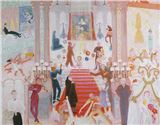The Mythic Method: Classicism in British Art 1920ÔÇô1950
The first major exhibition to explore how Modern British artists were drawn to the antique, and the question of how they developed a distinctive form of modern art that referenced the past, whilst also reflecting social and artistic concerns of the 20th century. The exhibition will offer a stimulating reassessment of a neglected and significant aspect of Modern British art.
The exhibition exploring how Modern British artists drew on classical myth and ideals in a ÔÇÿreturn to orderÔÇÖ following the First World War. Featuring playful and Surreal versions of Greek myths from the 1920s and 30s by the likes of John Armstrong, William Roberts and Edward Burra; idealised depictions of stylish contemporary goddesses by Meredith Frampton, Dod Procter and Wyndham Lewis; studies for ambitious mural schemes by Vanessa Bell, Duncan Grant and Eric Ravilious; and classically inspired sculptures by Frank Dobson, Henry Moore and Glyn Philpot, the exhibition gives a fascinating new insight into how modern art met with tradition in an era of social and political change in the early 20th century.
While modern art might be thought to abandon the classical ideals of ancient sculpture, in the 1920s and 1930s there was a resurgence of classicism within British art and culture as both traditional and modernist artists sought to reassert the enduring values of tranquility and order in an era of great social and political change. In the search for a dignified language for mourning and commemoration following the First World War many artists employed classical symbolism to reference the idealised virtues of Ancient Greece and Rome. This was manifested in a revival of interest in the tradition of mural and tempera paintings depicting classical compositions drawn from mythology and literature. Yet this espousal of classicism was also adopted by avant-garde artists who were to turn away from abstraction and the machine in favour of an idealised classical style, just as the European modernists including Pablo Picasso, Fernard L├®ger, Giorgio de Chirico and Gino Severini had done in the 1920s.

Recommended for you
The first major exhibition to explore how Modern British artists were drawn to the antique, and the question of how they developed a distinctive form of modern art that referenced the past, whilst also reflecting social and artistic concerns of the 20th century. The exhibition will offer a stimulating reassessment of a neglected and significant aspect of Modern British art.
The exhibition exploring how Modern British artists drew on classical myth and ideals in a ÔÇÿreturn to orderÔÇÖ following the First World War. Featuring playful and Surreal versions of Greek myths from the 1920s and 30s by the likes of John Armstrong, William Roberts and Edward Burra; idealised depictions of stylish contemporary goddesses by Meredith Frampton, Dod Procter and Wyndham Lewis; studies for ambitious mural schemes by Vanessa Bell, Duncan Grant and Eric Ravilious; and classically inspired sculptures by Frank Dobson, Henry Moore and Glyn Philpot, the exhibition gives a fascinating new insight into how modern art met with tradition in an era of social and political change in the early 20th century.
While modern art might be thought to abandon the classical ideals of ancient sculpture, in the 1920s and 1930s there was a resurgence of classicism within British art and culture as both traditional and modernist artists sought to reassert the enduring values of tranquility and order in an era of great social and political change. In the search for a dignified language for mourning and commemoration following the First World War many artists employed classical symbolism to reference the idealised virtues of Ancient Greece and Rome. This was manifested in a revival of interest in the tradition of mural and tempera paintings depicting classical compositions drawn from mythology and literature. Yet this espousal of classicism was also adopted by avant-garde artists who were to turn away from abstraction and the machine in favour of an idealised classical style, just as the European modernists including Pablo Picasso, Fernard L├®ger, Giorgio de Chirico and Gino Severini had done in the 1920s.
Contact details















